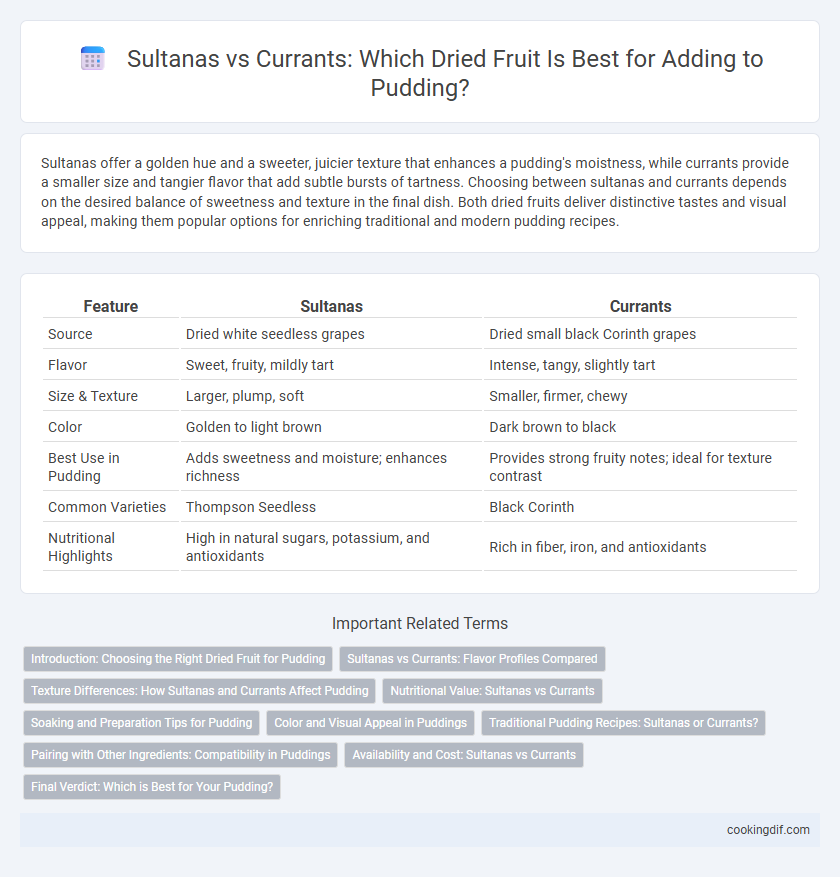Sultanas offer a golden hue and a sweeter, juicier texture that enhances a pudding's moistness, while currants provide a smaller size and tangier flavor that add subtle bursts of tartness. Choosing between sultanas and currants depends on the desired balance of sweetness and texture in the final dish. Both dried fruits deliver distinctive tastes and visual appeal, making them popular options for enriching traditional and modern pudding recipes.
Table of Comparison
| Feature | Sultanas | Currants |
|---|---|---|
| Source | Dried white seedless grapes | Dried small black Corinth grapes |
| Flavor | Sweet, fruity, mildly tart | Intense, tangy, slightly tart |
| Size & Texture | Larger, plump, soft | Smaller, firmer, chewy |
| Color | Golden to light brown | Dark brown to black |
| Best Use in Pudding | Adds sweetness and moisture; enhances richness | Provides strong fruity notes; ideal for texture contrast |
| Common Varieties | Thompson Seedless | Black Corinth |
| Nutritional Highlights | High in natural sugars, potassium, and antioxidants | Rich in fiber, iron, and antioxidants |
Introduction: Choosing the Right Dried Fruit for Pudding
Sultanas offer a plump, sweet flavor with a golden hue that enhances the moist texture of puddings, while currants provide a smaller, more tangy burst of flavor with a darker color that adds depth to the dish. Both dried fruits contribute natural sweetness and chewiness, but sultanas tend to retain moisture better during baking, making them ideal for richer, softer puddings. Selecting between sultanas and currants depends on the desired taste intensity and visual appeal, with sultanas favored for gentler sweetness and currants for robust, concentrated flavor.
Sultanas vs Currants: Flavor Profiles Compared
Sultanas offer a sweet, juicy flavor with a plump texture, making them ideal for adding moisture and natural sweetness to puddings. Currants deliver a tart, slightly tangy taste with a chewy bite, providing a contrasting acidity that balances rich desserts. Choosing between sultanas and currants depends on whether a sweeter or more complex, tart flavor profile is desired in the pudding.
Texture Differences: How Sultanas and Currants Affect Pudding
Sultanas provide a plump, juicy texture that adds moisture and a subtle chewiness to pudding, enhancing its overall softness. Currants contribute a firmer, denser bite with a slightly tart flavor that creates a contrast in texture, making each spoonful more complex. The choice between sultanas and currants significantly influences the pudding's mouthfeel, with sultanas yielding a smoother, more succulent consistency and currants offering a more textured, robust experience.
Nutritional Value: Sultanas vs Currants
Sultanas contain higher natural sugars and calories compared to currants, making them a sweeter option for pudding recipes, while currants offer a slightly lower calorie count with more concentrated antioxidants and dietary fiber. Both dried fruits provide essential minerals such as potassium and iron, but currants typically have a richer vitamin C content, supporting immune health. Incorporating either sultanas or currants enhances the nutritional profile of puddings by adding natural sweetness alongside essential nutrients and antioxidants.
Soaking and Preparation Tips for Pudding
Soaking sultanas in warm water or alcohol for at least 30 minutes plumps them, enhancing moisture and sweetness in pudding. Currants, being smaller and drier, benefit from a quick rinse and brief soak to prevent them from absorbing too much liquid and becoming overly mushy. For optimal pudding texture, drain excess soaking liquid and gently fold the soaked dried fruits into the batter just before baking.
Color and Visual Appeal in Puddings
Sultanas provide a golden hue that brightens puddings, enhancing visual appeal with their large, plump appearance. Currants offer a deep, rich color that creates a striking contrast, lending a sophisticated look to desserts. Choosing between sultanas and currants impacts pudding aesthetics, influencing both color vibrancy and texture differentiation.
Traditional Pudding Recipes: Sultanas or Currants?
Traditional pudding recipes often call for sultanas due to their larger size, golden color, and sweeter flavor, which provide a moist texture and rich taste. Currants, smaller and darker, offer a more intense, slightly tart flavor that creates a denser fruit distribution throughout the pudding. Choosing between sultanas or currants depends on whether a sweeter, softer pudding or a more robust, textured fruit presence is desired.
Pairing with Other Ingredients: Compatibility in Puddings
Sultanas offer a sweet, plump texture that pairs exceptionally well with creamy pudding bases, complementing flavors like vanilla and cinnamon. Currants provide a more intense, tart bite that enhances spiced or citrus-infused puddings, balancing richer ingredients such as chocolate or nuts. Choosing between sultanas and currants depends on the desired flavor profile, where sultanas create a mellow sweetness and currants introduce a flavorful contrast.
Availability and Cost: Sultanas vs Currants
Sultanas are generally more widely available and cost-effective compared to currants, making them a popular choice for pudding recipes. Currants, being smaller and often sourced from specific grape varieties, tend to be less common and priced higher. The affordability and accessibility of sultanas contribute to their frequent use in commercial and homemade puddings.
Final Verdict: Which is Best for Your Pudding?
Sultanas offer a sweeter, juicier burst and a golden hue, enhancing both flavor and appearance in puddings, while currants provide a tart, tangy complexity with a deeper color and a denser texture. For fruity puddings requiring subtle sweetness and vibrant aesthetics, sultanas are ideal; currants excel in traditional, richly spiced recipes where bold flavor contrast is desired. Choosing between sultanas and currants ultimately depends on the pudding's flavor profile and desired texture, with sultanas favored for moist, sweet desserts and currants preferred for intensity and chewiness.
Sultanas vs Currants for dried fruit addition Infographic

 cookingdif.com
cookingdif.com